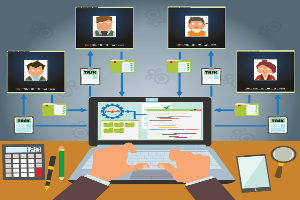
If you want to be an effective leader, you must have strong communications skills and a good amount of composure. In today’s workforce, the only thing that separates one leader from the next, is how they communicate, handle conflict, and lead. Being a team leader can be an incredibly rewarding role but it comes with its challenges. And while handling difficult conversations may be the least appealing part of managing employees, it’s an important part of leadership that every manager should be prepared for—whether it’s about poor performance, attendance, peer conflict, or behavioral issues, these conversations are ultimately inevitable in any workplace dynamic.
It’s common for defenses to be high when having a difficult conversation, so it’s imperative that you have a plan for when they come about. Prepare ahead of time and pick a neutral time when it’s calm. Go into the conversation with an open mind and ready to listen. It takes a nanosecond to invoke defensiveness—employees may respond with a blank stare, a passive sigh, or even an angry rebuttal so be clear and concise, using non-defensive communication while also being professional and friendly in nature. Poor communication can affect morale, performance goals, and sales so take some time to ensure you know the facts and have a plan for whatever response you may get.
Below are some do’s and don’ts on how to effectively (and respectfully) navigate difficult conversations in the workplace while maintaining morale, fostering trust, and maximizing productivity.
Difficult conversations can be awkward and unpleasant but with some thoughtful tactics in your back pocket, you can successfully address a tough situation and find effective solutions to whatever issues may arise while also ensuring you maintain respect with your team.

Question: Can I ban cell phones at work? How about audio and video recordings?
Answer: This question has brought up issues that have been the subject of recent litigation, so it’s a great time to be asking.
To answer your first question: yes, you can limit or even prohibit use of cell phones during work hours. Employees can be expected to give their undivided attention to the work you pay them to perform, and if that means cell phones need to be turned off or put away, you are entitled to make this request. However, employees should be allowed to use cell phones during their break and meal periods, as this time needs to be truly their own in order to satisfy the requirements of state law. Fair warning: if you attempt to prohibit cell phone use during all non-break time, you may receive some fairly aggressive push back. A more lenient policy may do the trick. Typical standard language says, “Personal cell phone use should be kept to a reasonable limit during working hours. Reasonableness will be determined by your manager.” This language gives your managers considerable discretion, but they should be trained to use the same standard of reasonableness for all employees to avoid claims of discrimination.
To answer your second question: no, audio, video, and photography cannot be strictly prohibited, but they can be limited. The National Labor Relations Board, which enforces the National Labor Relations Act, has said that employers cannot outright prohibit recordings as this could interfere with employees’ ability to organize with respect to their terms and conditions of employment. For instance, employees might choose to record a conversation during their lunch hour related to asking for raises and want to share that recording with employees who work different shifts. This would need to be allowed. However, you can still have a policy that prevents recording (via audio, video, or photograph) confidential information, such as proprietary business practices, customer lists, client or patient information, or employees’ personal information. Be aware that you cannot deem all information confidential, e.g. “all conversations in the office” or “anything related to customer/patient care.”
If you feel it is important to have such a policy, you may say something like, “Audio and video recording devices, including cameras and smartphones, may not be used to record or capture any confidential information, whether it is proprietary business information or clients’ or employees’ confidential personal information. If recording non-confidential information, e.g. taking photos of colleagues, please seek the consent of all parties to the recording.” A policy like this can be added to your handbook during your next handbook review, or if you feel the need is urgent, you can distribute it to all employees now and have them sign an acknowledgment form.
This Q&A was provided by Mineral, powering the UST HR Workplace. Have HR questions? Sign your nonprofit up for a FREE 60-day trial here. As a UST member, simply log into your Mineral portal to access live HR certified consultants, 300+ on-demand training courses, an extensive compliance library, and more.

Leadership development is an attractive benefit that is becoming commonplace in the current job market. About half of Millennials expect their company to help pay for leadership training, and 60% say they’d prefer a job that provides professional development over one that provides regular pay raises.
How Know-How Helps
First, employees want to gain mastery over current job and life challenges. But then, one in five will leave their current position in search of a job that provides additional professional development opportunities. Nearly a third of workers say education would help them feel more engaged and loyal. Yet fewer than half of businesses offer leadership training. Even fewer offer mentoring or career counseling. Think about offering all that with these four levels of staff development.
Try to make education an ongoing process with multiple built-in opportunities. On-the-job training can be the most cost-effective approach for smaller organizations. Coaching fosters teamwork and saves funds by working internally. Leadership education is important to succession planning as well as retention. Whatever their path, give employees the opportunity to practice and implement the skills and knowledge they have gained.
Leadership Realities
In the past, businesses had two ways of moving people up to leadership levels: Climbing the ladder through promotions or following a career path that included educational leadership development. Today’s post-recession workers feel the need to protect their careers from further economic downturns by staying employed where they can receive training and development. In a tight market, you should expect to include some training in their benefits package. The best practice for this situation is to make an effort to align their leadership development with the anticipated needs of your nonprofit.
Your nonprofit might be overdue in training new leaders. Baby Boomers who started organizations decades ago are retiring or preparing to retire from their leadership positions. Add to that, about half of current young professionals will leave the nonprofit sector. If you’re facing an upcoming leadership crisis, by all means focus on leadership training. Your workforce will enjoy a successful career path, and your nonprofit will benefit from well-trained leaders who know how to take your organization forward.
Development 101: Begin Simply
One of the best ways to offer career development is to build leadership skills through practical hands-on experience. It will help your managerial staff to know their organization well so encourage managers to delegate and coach where needed in order to build a list of success stories. Some cost-effective ideas to start you in the process include:
A Sensible Approach
While you’re considering how to best juggle all the possible educational benefits, take a pragmatic look at the costs. There’s a simple formula you can use to maximize educational effectiveness without breaking the budget. The Center for Creative Leadership promotes a cost-effective model for leadership development that you should consider:
Many nonprofits fail to follow this guiding principle and the result is often an unfocused, unsuccessful training program that does little more than pay lip service to the idea of leadership development.
Make Mentoring Happen
Do your managers notice emerging leaders in their teams? You can design a formal mentoring program or keep it informal, as you see fit. Make sure they have a safe space to learn so that they can accelerate learning. Allow time during work for mentoring sessions. If your nonprofit cannot support an internal mentoring program, you may be able to partner with other local organizations and businesses for potential mentors. Resources include the Aspire Foundation, which provides global, free online mentoring to women working in nonprofits. Search online to find the numerous mentor-training resources available.
Affording Formal Training
As you know, finding adequate funds for your training initiatives can be a challenge. There are ways to leap past those hurdles. Here are some possible means of funding formal leadership development in your nonprofit:
Funds spent on leadership training provide high returns on investment (ROI). And this ROI isn’t just fiscal. It’s a great way to increase your mission impact, bring in higher revenues, control costs and provide for greater stability as you build employee loyalty. Strengthen your training programs to focus on success in achieving leadership roles, and employees will stay as they reach for the heights of leadership succession.
Logic Dictates
A recent study showed that only a third of nonprofit executives rose through the ranks of their organization. If two-thirds of nonprofits are having to hire executives from outside, that suggests they lack appropriate leadership development. They may even be neglecting larger strategic issues. The results of this lack of focused strategy means that nonprofits are not rising to meet the challenge of diversifying their leadership in race, ethnicity, or educational background. It’s critical that they improve their ability to groom talent from within.
You may experience push-back from an executive who doesn’t want to dedicate resources to leadership development. The truth is, some leaders dislike the idea of training their replacements. It makes them feel that their time is coming to an end. If that’s true in your nonprofit’s case, you will need to explain that a strong leader is someone who prepares for the inevitable, which includes future changes. It will likely help if your organization’s board of directors makes succession planning a part of the job description for all executives. A legacy can be ruined by leadership succession that is ill-planned. Instead, your executive has the opportunity to make an enduring mark on your organization by leaving it in capable hands.
And, often, the best way to do this is to promote from within.
This is an excerpt from UST’s eBook, “Innovative Strategies That Overcome Nonprofit Retention Barriers” in collaboration with Beth Black, Writer and Editor.
If you’d like to see more content like this, check out UST’s Content Library that houses our most popular nonprofit resources, including on-demand webinars, toolkits, eBooks, guides, & more!

Question: What are effective ways to manage remote employees and monitor their work?
Answer: Managing remote employees can certainly be a challenge. Here are some of the practices we recommend:
This Q&A was provided by Mineral, powering the UST HR Workplace. Have HR questions? Sign your nonprofit up for a FREE 60-day trial here. As a UST member, simply log into your Mineral portal to access live HR certified consultants, 300+ on-demand training courses, an extensive compliance library, and more.

As of early 2020, the nonprofit employment sector is reported to be the third largest in the nation, following manufacturing and retail. Job statistics will no doubt remain unsteady in the next few years, as unfolding events put these employers at risk. Beyond catastrophic demands placed on them for services, a lot of nonprofits also had to deal with financial losses caused by the pandemic. The result is that you are likely dealing with the ramifications caused the Great Resignation, not to mention facing financial challenges in hiring right-fit people for your organization. One important way to attract more qualified candidates — and retain them — is to hire managers who support and sustain their teams.
Recognize Your Challenges
Have you done all you can to assure that every manager in your organization has the temperament and training to effectively run a department without alienating staff? The challenges you face can be daunting. You may be forced to offer lower compensation for longer work hours. Additionally, slow progress toward your mission’s goals can weaken your employees’ resolve to stay. So, while burnout might be a problem, your bigger challenge might be finding enough qualified candidates who are inspired by your mission.
Specific skills can be taught in most cases, or an inventive employee might come up with smart ideas to improve your processes. Also, consider work and life experience, because in an often-gritty world, your organization could draw strength from people who have life lessons to share. Contract workers can transition into excellent full-time employees. The one common denominator they must all have is passion. Be sure to ask for their story. Find out what happened that brought them to your office and you might be impressed by what you hear.
Manage Your Talent
You want the right person for the job. You can also find the right job for the person. Either way, you should consider the following guidelines to boost your success over the long haul:
Your Managers
As individuals, companies, industries and nations work to rebuild after upheaval, workers need a paycheck, of course. But along with that, they need a strong sense of purpose and opportunity. When they feel that, your staff members will engage, perform, commit to staying and seeing your nonprofit through challenges that lie ahead. The only way to ensure that dedication and loyalty in workers is to provide them with leadership that supports their efforts, trusts them to perform and guides them toward future successes.
Make sure your managers:
Additionally, here are five core qualities that every management candidate should possess. Whether you’re promoting from within or seeking someone new, make sure to look for someone who:
Take the opportunity to review your leadership development options and implement what you need to develop managers who have these qualities and can prioritize this kind of conduct. Strong, appropriate leadership is an urgent need, and equipping future leaders with these critical skills will help to assure your nonprofit meets the demands of the future.
Acing the Interview
Success in an interview is often talked about from the perspective of a candidate. But the truth is, the interviewer should design a session that illuminates qualities of the candidate, teases out relevant details and helps the team make a decision.
Prepare questions that can bring out specifics. Instead of “yes/no” questions, ask about issues and strategies a candidate might devise to help her teamwork through them. To learn, for example, if a potential manager would have their backs, you might ask what that person would do if a team member admitted making a mistake. What would they do? Would they take away the project and finish it on time? Would they work through the mistake together with the employee to fix it? Listen for their answers to understand how they might succeed or fail with respect to the traits listed above.
Once all blind interviews have been conducted, allow yourself to cautiously acknowledge general first impressions on finally meeting a new candidate. Does that person make eye contact? Greet others with a smile?
Lose Your Implicit Bias
You want to trust your “gut feeling” about a candidate, but the truth is that you must do so with caution. Implicit bias happens when you allow stereotypes and preformed attitudes to affect your actions on a subconscious level. It can make you misread your emotional responses to a person you don’t know. We are all hardwired to prefer people who are similar in some ways, so it’s important to pay attention at every step in the process and take action to remove implicit bias, as much as possible.
Take steps to control it by asking yourself these questions as you work through your hiring process:
If, after you’ve gone through a thorough vetting and interviewing process, removing as much implicit bias as possible, you still feel some nagging doubts about a person, then try to understand why you feel that way. Ask other team members for their input and find out if they have the same reaction. And try not to rush the process. At some point, you will have to make a decision. Make it your best possible effort.
Ultimate Interview Tips
Escape the trap of the traditional interview by using a little imagination. Consider these three principles to gain a clearer picture of the person you’re interviewing:
Beyond the Interview
These days, it’s easy enough to check any candidate’s social media profiles as well as their references. If you can arrange extra reference checks in addition to those provided by the candidate, you’ll probably learn more. Be sure to ask about their behavior under stress as well as how that person worked with others. And remember, what that person has accomplished, what goals they’ve reached and challenges they’ve overcome, really do matter more.
This is an excerpt from UST’s eBook, “Workforce Management Tactics that Strengthen Nonprofit Brands” in collaboration with Beth Black, Writer and Editor.

Question: How can we make sure our online trainings are effective?
Answer: Online trainings can be a useful tool for developing talent, but they can also end up being a waste of time and resources, even if the content and presentation are good. The difference between effective and ineffective training often comes down to whether employees are able to absorb and retain the information they receive.
There are lot of obstacles to absorption and retention of trainings. Busy employees may listen to a webinar while they work on other things, catching only tidbits here and there. Or they may put a training video off until they’ve finished a project and are too exhausted to give it due attention.
To avoid these training pitfalls, consider these three tips:
Follow the AGES Model. The NeuroLeadership Institute argues that we learn quickly and retain information best when we focus on one topic (attention), actively connect what we learn to what we already know (generation), experience positive feelings while learning (emotion), and space our intake of information (spacing). For example, cramming training on multiples topics into a tight two-day workshop would be much less effective than spreading that training out over a few weeks. You can learn more about the AGES Model here.
Give employees time to reflect and practice the skills they’ve learned. In some professions, like music and athletics, you spend most of your work time learning, building, and reinforcing skills before the big performance, whether it’s a concert, game, or race. Good performance necessitates constant practice. But in most professions, practice seems like a luxury you can’t afford because you’re expected to be performing during your work time. This is one reason trainings fail to deliver results. To master new skills, employees need time to focus on building those skills. That means some work time needs to be set aside post-training for them to reflect on and practice what they’ve learned.
Align trainings with the present needs and future goals of both the company and the employee. When assessing employee training goals, consider what additional knowledge and skills would enable them to do their jobs better now, but also set them up for success in their future careers. Employees are more likely to be excited by and personally invested in their training if they understand their personal return on that investment. If they don’t recognize its value, it won’t have any value to them.
This Q&A was provided by Mineral, powering the UST HR Workplace. Have HR questions? Sign your nonprofit up for a FREE 60-day trial here. As a UST member, simply log into your Mineral portal to access live HR certified consultants, 300+ on-demand training courses, an extensive compliance library, and more.

Without the staff to support your mission-driven initiatives nonprofits across the globe wouldn’t exist. Recognition plays a huge role in employee satisfaction and job longevity so it’s imperative that you implement strategies that work solely to create an employee experience that keeps employees engaged, productive and loyal. Employers who take steps to celebrate successes—professional and personal– while also encouraging employees to celebrate each other create a positive work environment where employees are happy.
There are many ways to celebrate and recognize employees that aren’t the obvious award ceremony. It’s important to consider your employees’ preferences for recognition as some people don’t enjoy being the center of attention but may not mind receiving recognition via email vs. in person. Using a short survey to get a feel for how everyone prefers to be celebrated and what kinds of rewards they’d like can go a long way in making sure your efforts don’t fall flat. The last thing you want to do is embarrass anyone you’re trying to celebrate or praise. It might take a little more effort to personalize your recognition program but in the long run it will be well worth the time spent surveying employees to better understand personalities.
Celebrating successes not only improves morale but it can also help to boost confidence, decrease absenteeism and strengthen your organization’s reputation. Discover some of the ways UST celebrates its employees in our 5 Creative Ways to Celebrate Your Team and add them to your employee engagement initiatives. Having a strong culture of praise and encouragement is a win-win for all involved and in this day and age employee retention efforts are vital to the success of your nonprofit.

Employees are the backbone of every nonprofit and your most valuable asset—contributing to the overall success (or failure) of your organization. When employees are engaged and excited about the work they do, you’ll experience increased productivity, improved job performance and higher retention rates. A key factor in employee satisfaction is career advancement and development opportunities which shows your workforce that you care about more than just hitting your numbers.
In an effort to keep employees engaged, employers must invest in their time and resources in training and development initiatives. It’s imperative that both employers and employees take skill enhancement activities seriously to ensure longevity of individual careers and organizational goals. The importance of offering training and development is more important than ever as employees continue to leave their current jobs for ones with better benefits and growth opportunities.
In a recent article by Intoo, “7 Ways to Help Your Employees with Career Development,” they discuss how you can contribute to the professional advancement of your employees with helpful tips for providing employees the tools they need to advance their career with your organization.
This article was originally published by UST’s outplacement partners at Intoo and is being shared with their permission.

Modern benefits are indeed useful for retention but that is not the whole story. To be fully engaged, nonprofit employees need to feel they have a say in what goes on at work. The trick is, you must involve your staff in developing and implementing the critical cultural and environmental initiatives designed to engage them in their work. The following strategies for this are intuitive, low-cost and easy to execute.
Common Keys to Engagement
Studies have long proven that engaged employees are more likely to stay and disengaged employees are more likely to leave. But the question remains, how do you quantify, support and grow engagement? The 2018 State of the Workforce Management Report advises that a stressful work environment was tracked at 21% of reasons for failed retention, and limited opportunities for advancement cause more than one in ten employees to quit their job. You can avoid this by sharing openly how and when your nonprofit will remedy any such situation.
Make this dialogue part of a strategic retention plan to prevent and solve the crisis of disengagement. While setting up and maintaining a viable set of strategies presents its own challenges, they are minimal compared to problems posed by a lack of preparation. Another recent report²⁰ shows that 18% of executives say a lack of an employee engagement strategy is the biggest challenge they face. They’re troubled by “an inability to measure and assess engagement” — a situation you can address by following some basic guidelines mentioned in this section. Then, you can solicit managers and employees to improve their work experience.
FIRST FOCUS: MAKE THE MOST OF YOUR MANAGERS
According to TLNT.com, “Up to 75% of the factors that frustrated [lost workers] and caused them to begin looking elsewhere were controlled by their manager.” Advise your managers to get actively involved in working with staff on employee engagement and retention initiatives. Provide them with the tools to keep their staff happy and watch your retention levels rise.
Loyalty Leaders
A surprising half to three-quarters of all turnover is actually preventable, if managers know how to implement all the tools and strategies available. Do your managers have the tools they need? Help them to develop a loyalty leader mindset²¹, and your team will benefit greatly. Knowing what to suggest to managers can help in times when most employees are “at will” and free to resign, with or without notice.
Following are some low-cost Retention Tools provided by TLNT.com for managers that produce high-impact results:
Conduct “stay interviews.” Ask current employees why they choose to stay. Once you know, you can implement strategies to support these reasons.
Every one of the above recommendations will serve your organization well if used appropriately. Care should be taken, however, to follow the “spirit” that underlies this list: Know your employees’ needs. If a manager has a longtime staff member who is overdue for promotion, sending an email of thanks for a successful project could backfire. This is especially true if the employee has been watching younger staff members hopscotch past them
SECOND FOCUS: GO STRAIGHT TO THE SOURCE, THE STAFF
You’ve begun improving staff engagement by working with managers, but it’s also critical to solicit employee involvement directly. Colorado Nonprofit Association Director of Membership Services Gerry Rasel has the distinct experience of working for a nonprofit that supports best-practices in other nonprofits. Personal experience informs her work. “My best tip for any nonprofit is that it’s always about listening to your staff,” she said. “I work at a place that is really, really good at that. As an employee, the respect I feel and the knowledge that my opinion is heard goes a long way to keeping me engaged at work.”
Share timelines and give your employees a voice in the organization’s retention initiatives. Implementing a plan is a critical beginning, but it’s important to update your strategies regularly, and to do so you should hear the voices of your employees. Not all nonprofits make that effort. Nearly three-quarters of nonprofit executives make a conscious effort to engage employees, but only 37% report that they’ve recently updated their employee engagement plan. This reveals the underlying issue that many nonprofits fail to formalize their engagement plan schedule as much as they formalize other routines in the organization. With a formal schedule in place to ask, listen and respond to your staff members, you’re more likely to raise employee engagement and hold it at acceptable levels. More than 70% of nonprofit executives surveyed cited “Increasing Employee Satisfaction & Engagement” as a priority. The only priority that earned a higher number was “Recruiting and Retaining Top Talent.” So, whatever you can do to increase employee engagement and retention will go a long way to meeting what are likely the top two priorities of your nonprofit’s leadership.
A Culture of Action
Dialoguing with your staff is important, but it can also be risky. If employees share their ideas but nothing is implemented — there’s no active response — they will disengage altogether, quickly. You can prevent that disaster by moving forward efficiently with a culture that supports communication and action. Organize their input into four distinct areas for a coordinated response:
1. Leadership.
2. Enablement.
3. Alignment.
4. Development.
You shouldn’t throw everything at all four engagement areas at once. Don’t risk chaotic and failing programs, especially when funding is tight and time to devote to these initiatives may be short. Organizations that report the most impactful results carefully select one or two projects at a time.
Go Beyond
The good news is many engagement initiatives suggested from for-profits already happen in nonprofits. While your for-profit competition is trying to align their company with a purpose, your nonprofit has made a mission of it. Now, build on that with ideas that go beyond the usual:
Think creatively, proactively and prudently, and you’ll discover a multitude of affordable ways for your team to become involved in developing their own reasons for engagement.
his is an excerpt from UST’s eBook, “Innovative Strategies That Overcome Nonprofit Retention Barriers” in collaboration with Beth Black, Writer and Editor.

“Round and round and round she goes, and where she stops, nobody knows.”
~ Major Bowes Amateur Hour, c. 1930s
Nonprofits across America are facing the same situation. Rising demand for services in the face of a severe labor shortage. Each part of this problem aggravates the other, until it might seem that you’ll never find a way out of all the struggles. To be sure, the pandemic triggered some thorny nonprofit sustainability challenges, such as the Great Resignation. But let’s be honest — a lot of the problems currently overpowering the American workforce have been brewing since well before COVID-19. In this post, we’ll take a look at where we are today, how we got here, and what you can do to help your staff cope with that wild and wicked ride known as STRESS.
Where We Stand
Mental Health America (MHA) reported in April that 70% of American employees they surveyed last year were finding it difficult to concentrate at work. The study of 11,300 US employees shows a precipitous rise in the stress symptoms employees are feeling from 65% in 2020 and 46% in 2018. Of course, the pandemic has played a large role in this, but we should also consider other factors. Clearly, the events of 2022 — even with the easing of some pandemic pressures — have done very little to assuage workers’ concerns.
With everything going on in the nation and the world, it’s no surprise that American workers are feeling vulnerable and anxious. Threats to personal wellness and safety constantly lead national news stories. Included in the mix, COVID-19 still looms, and inflation has tugged at the nonprofit worker’s ability to make ends meet. Your employees must heap these external fears upon the traditional career concerns, which results in pernicious workplace stress.
How We Got Here
Consider the most common stress-inducing problems related to workplace culture. These remain unchanged from survey reports of years past. Lack of recognition for employees’ contributions remains a problem. There’s also workplace harassment which unfortunately, some nonprofits have done little to address. Left unhandled, this kind of problem will not only stress employees to the point of burnout, it will stain your employer brand permanently.
Also, many nonprofits lack a real path to career success for everyone, not just a chosen few. Developing a culture of support in all areas has been difficult for many nonprofits. The MHA survey reported that:
The survey lists more illustrations of problems taking place in America’s workplace cultures. If you haven’t done so lately, this is a good time to survey your own team for their particular stressors. It will be no surprise that different fields bring varying challenges; medical nonprofits often face compassion fatigue while workers in educational nonprofits can be stressed by low pay. Find out what is ailing your staff, so you can determine the best way to address those issues.
Unrest From Uncertainties
With the advent of the Great Resignation, positions are staying unfilled longer, which means that remaining employees are exhausted. Like riders unable to escape an eternally moving carousel, the fact that they are stuck in such an uncertain and incessant situation will no doubt make it feel worse. Even the most dedicated workers will eventually burn out. Nonprofit leaders who have failed to carefully balance workloads between remaining team members will likely notice this more than others.
After more than two years working remotely, some employees are still just simply not ready to return to onsite work. While a number of nonprofits have required workers to return, the fact remains that this is causing stress for those who don’t yet feel safe in the workplace. Help them adjust by ensuring that you keep up with current CDC guidelines in knowledge and practice. Then, communicate your safety practices. Transparency will ease tension. As COVID-19 case rates rise and fall, help your employees trust that you are going to do everything in your power to keep them safe, which includes establishing a caring culture.
Even remote workers may be feeling stressed about their careers. Take steps to account for proximity bias, an unconscious preference that leaders feel toward staff members they see in person over employees who aren’t onsite.
Uncertainty remains a huge stressor. This is the “nobody knows” part of the rhyme above. Unclear or changing job expectations will cause your employees to lose faith in their abilities to meet your demands. Uncertainty is a given in today’s world, but vague job performance expectations will only add to the weight they shoulder regarding overall career ambiguity, organizational changes, and even the dread of workplace violence.
Individuals & Organizations
Eight in 10 of the survey respondents stated that the stress from work affects their relationships with friends, family, and co-workers. Of course, it also affects their employers.
Stressed workers exhibit lowered performance, possibly due, in part, to lack of sleep. They become anxious and uncommunicative. At some point, most burn out and quit. This has been part of the Great Resignation, particularly for nonprofit employees suffering low-pay issues. They will resign to find better paid jobs in another industry, if that’s what it takes to escape the stress of unpaid bills. Longtime employees who have always taken strength from their belief in your mission might lose that resolve when they can’t afford to put gas in their car or food on their table.
Employers have been using temporary or contract workers to fill talent gaps, which can help in the short term. But bear in mind that this rarely provides a long-term solution. It’s an employees’ job market, and unless they want to work on-call, gig workers are finding opportunities to move up to full-time positions that have become more available.
When workers are stressed, job satisfaction scores plummet. Turnover becomes a problem and hiring new staff with a tarnished employer brand will be difficult.
Steps to Take
Here are some steps that can help destress your staff and keep your nonprofit moving forward:
UST’s Content Library provides valuable resources to help you halt that stressful unmerry-go-round, so your staff can find their footing on solid ground, once again.
This blog post was written by Beth Black, consulting writer and editor to UST. Visit PracticalPoet.com to view Beth’s online portfolio and learn more about her editorial services.

UST maintains a secure site. This means that information we obtain from you in the process of enrolling is protected and cannot be viewed by others. Information about your agency is provided to our various service providers once you enroll in UST for the purpose of providing you with the best possible service. Your information will never be sold or rented to other entities that are not affiliated with UST. Agencies that are actively enrolled in UST are listed for review by other agencies, UST’s sponsors and potential participants, but no information specific to your agency can be reviewed by anyone not affiliated with UST and not otherwise engaged in providing services to you except as required by law or valid legal process.
Your use of this site and the provision of basic information constitute your consent for UST to use the information supplied.
UST may collect generic information about overall website traffic, and use other analytical information and tools to help us improve our website and provide the best possible information and service. As you browse UST’s website, cookies may also be placed on your computer so that we can better understand what information our visitors are most interested in, and to help direct you to other relevant information. These cookies do not collect personal information such as your name, email, postal address or phone number. To opt out of some of these cookies, click here. If you are a Twitter user, and prefer not to have Twitter ad content tailored to you, learn more here.
Further, our website may contain links to other sites. Anytime you connect to another website, their respective privacy policy will apply and UST is not responsible for the privacy practices of others.
This Privacy Policy and the Terms of Use for our site is subject to change.
UST maintains a secure site. This means that information we obtain from you in the process of enrolling is protected and cannot be viewed by others. Information about your agency is provided to our various service providers once you enroll in UST for the purpose of providing you with the best possible service. Your information will never be sold or rented to other entities that are not affiliated with UST. Agencies that are actively enrolled in UST are listed for review by other agencies, UST’s sponsors and potential participants, but no information specific to your agency can be reviewed by anyone not affiliated with UST and not otherwise engaged in providing services to you except as required by law or valid legal process.
Your use of this site and the provision of basic information constitute your consent for UST to use the information supplied.
UST may collect generic information about overall website traffic, and use other analytical information and tools to help us improve our website and provide the best possible information and service. As you browse UST’s website, cookies may also be placed on your computer so that we can better understand what information our visitors are most interested in, and to help direct you to other relevant information. These cookies do not collect personal information such as your name, email, postal address or phone number. To opt out of some of these cookies, click here. If you are a Twitter user, and prefer not to have Twitter ad content tailored to you, learn more here.
Further, our website may contain links to other sites. Anytime you connect to another website, their respective privacy policy will apply and UST is not responsible for the privacy practices of others.
This Privacy Policy and the Terms of Use for our site is subject to change.